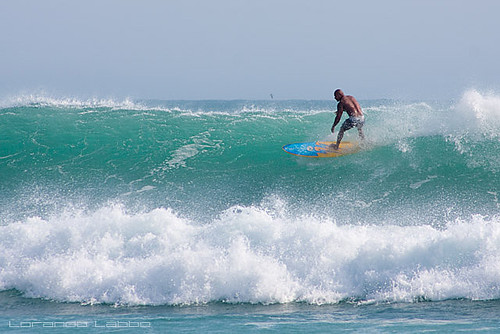Begginner “How to surf” series: How to surf a wave in 3 hours

- You know your good when…
![]() photo credit: lorando.labbe
photo credit: lorando.labbe
First get out on the water. That is 80% of the effort. Everyone has their lazy days, so get surf buddies. Then get on a board and paddle out. To get out through the waves paddle straight into the wave (not at an angle which could flip you). You must be in a minimum depth of 1 metre of water to catch a wave, so paddle out. Wait until a wave has just passed then spin you board around, you dont want to be caught side on and flipped. So now you’re lying on the board pointing towards the shore, with waves running you down from behind. When you spot a wave that is radical enough for you, start paddling approximatley 2-5 metres in front of it. Paddle like MAD! And keep paddling even as the wave is taking you. The first time you ride a wave you can just let it happen and bodyboard it into the shore, then you can build up the confidence to catch a wave.
There are two methods of standing up, ’standard’ and ‘Knee up.’ To stand up Standard lie on the board, flat on your stomach and in the centre, your feet should just be touching the ‘tail’ of the board. The board should be balanced on the water, use your hips and body to keep the board balanced. The nose should be raised just a few inches out of the water. Adjust your weight forwards and backwards to lift the nose just a fraction out the water. Not too much, not too little: about 1-2 inches.
* Start paddling again and once your riding the wave, grip the edges of the board with white knuckles of determination. And do a pushup but keep your hips on the board. (For you yoga buffs this is the cobra position, which you can practice anywhere, anytime).
* Drag one foot fluidly (that means in one movement) and plant it in the centre of the board 90 degrees to the direction of travel.
* Use your arms to support you as you place your leg in the correct position
* Using your backleg just to balance put all your weight into the front foot and push up.
* You can slowly drag you backleg forwards while keeping your balance on your front leg
* You should aim to place your feet on the board like you do in rounders (cricket, baseball, softball etc). Both feet should be 90 degrees (pointing just a little bit towards the front) to the direction of travel and evenly spaced apart, and right on the centre line of the board.
You can practice the ‘pop up’ and stance on the beach. Just lie your board flat on the sand and pretend you are on the water. Imagine the paddle out, pop up and then adjust your stance. Keep your knees slightly bent tai chi style, but only as far apart as is comfortable. Most of important of all make sure your feet are on the centre line. If you don’t mind looking like a newbie (and there is nothing wrong with that) you can even draw a black permanent line down the centre of your board, and as you practice the pop up check to see if your feet are perfectly placed on the line. 99% of post popup bails (so you get up but you always bail) are due to feet not properly on the centre line.
If the standard method just doesnt work for you try the knee up technique. Paddle out, catch the wave, and instead of moving 1 leg forwards move both legs into a kneeling position . Then grip the rails of the board and slide one foot up so the knee is up against your chest, then slowly raise your self into a crouching position.
If you follow these instructions you WILL learn how to surf, within 3 hours of reaching the beach.